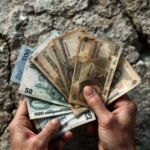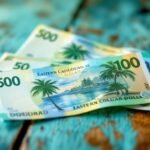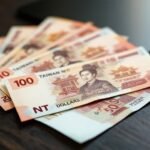
When traveling to Cusco, you'll use the Nuevo Sol (S/.), Peru's national currency divided into 100 cents. Coins range from 10 cents to 5 soles, and you'll want to carry cash, especially in smaller towns. Budget around $108 daily, with hostel stays costing S/.50-100 and local meals starting at S/.10. Exchange rates hover around 1 PEN = 0.2663 USD, with inflation stable at 2.06%. Always check banknote authenticity, use ATMs in busy areas, and mix cash with cards for safety. Your financial adventure through Peru's stunning landscapes has just begun – and there's much more to discover.
Key Takeaways
- The Nuevo Sol (S/) is Peru's official currency, divided into 100 cents, with denominations ranging from 10 cents to 1 Sol coin.
- In Cusco, budget travelers can expect daily expenses around S/150-200, with affordable accommodations ranging from S/50-100 per night.
- Local markets and *menús* offer budget-friendly dining options, with meals starting as low as S/10-20, making food costs manageable.
- When managing money in Cusco, use a mix of cash and cards, prioritizing cash in smaller towns with limited digital payment options.
- Exchange rates hover around 1 PEN = 0.2663 USD, with the Central Reserve Bank maintaining currency stability through strategic monetary policies.
What Is the Nuevo Sol?
Ever wondered about the currency that powers Peru's economy? The Nuevo Sol (S/) is Peru's official currency, with 1 Sol divided into 100 cents.
You'll find it's the primary medium for local transactions throughout the country. The sol comes in diverse coin denominations, including 5, 2, and 1 Sol coins, plus 50, 20, and 10 cent pieces.
Curiously, these sol denominations aren't just simple metal discs—they're intricate pieces of national art. Bi-metal coins feature stunning designs like the Nazca Lines' Hummingbird, while brass coins showcase the Pre-Columbian citadel of Chan Chan.
Each coin proudly displays the National Coat of Arms and is minted by the Banco Central de Reserva del Perú, representing Peru's rich cultural heritage through its currency. These coins are crafted with advanced anti-counterfeiting techniques to ensure their integrity and protect the nation's monetary system.
Historical Journey of Peruvian Currency
You'll encounter a fascinating narrative of monetary evolution as you explore Peru's currency history, marked by significant shifts driven by economic challenges and political changes.
From Spanish colonial reales to the modern nuevo sol, you'll witness how Peru's currency adapted through periods of inflation, economic instability, and systemic reforms.
You'll see how each currency change—whether from real to sol, sol to inti, or inti to nuevo sol—reflects broader economic and historical dynamics that shaped the nation's financial landscape. Monetary policy reforms have been crucial in stabilizing Peru's economic trajectory, helping transition from volatile inflationary periods to a more predictable financial environment.
Monetary Turmoil Era
Maneuvering through Peru's tumultuous monetary landscape reveals a complex history of currency evolution and economic challenges.
You'll find the 1980s marked a vital period of currency devaluation impacts, with hyperinflation soaring over 7,000% by 1990. The economic crisis devastated the national economy, causing GDP to contract over 20% and poverty to rise to 55%.
As part of economic recovery strategies, Peru introduced the inti in 1985, replacing the sol, and subsequently launched the nuevo sol in 1991. The foreign direct investment from key countries like the United States and Spain played a crucial role in supporting Peru's economic transformation during this challenging period.
These currency shifts were essential in stabilizing the economy. You'll notice the government eliminated exchange controls, restored full currency convertibility, and freed interest rates.
Currency Transformation Path
Throughout the historical trajectory of Peru's monetary landscape, the currency evolution path reveals a compelling narrative of economic adaptation and resilience. Exchange rate fluctuations have been a critical indicator of Peru's economic stability, demonstrating significant shifts in monetary valuation over recent years. You'll witness a fascinating journey from Spanish reales to modern nuevos soles, marked by strategic shifts in currency equivalence and monetary policy.
| Period | Currency | Key Characteristics |
|---|---|---|
| 16th-19th C | Spanish Real | Peso equivalence: 8 reales = 1 peso |
| 1822-1863 | Peruvian Real | Transitional decimal system |
| 1863-1985 | Sol | Gold-based primary currency |
| 1985-1991 | Inti | Named after Inca sun god |
The currency evolution reflects Peru's economic transformations, with each monetary iteration responding to inflation challenges and modernization needs. From conquistador-introduced coins to today's stable nuevo sol, you'll see how Peru strategically navigated complex financial landscapes, demonstrating remarkable monetary adaptability throughout its historical journey.
Exchange Rates and Economic Context

You'll want to understand how Peru's Sol has transformed through significant economic challenges, from dramatic inflation periods to current stability. The Sol's value reflects complex interactions between global economic trends, domestic policies, and key sectors like mining and agriculture. In 2024, the currency's gradual decline against the US Dollar highlights ongoing economic adjustments and the delicate balance of Peru's monetary landscape.
Sol's Historical Transformation
Tracing the evolution of Peru's currency reveals a tumultuous financial journey marked by dramatic changes and economic challenges. The sol's historical alteration reflects Peru's economic resilience, evolving through multiple currency iterations to combat hyperinflation and economic instability. The Central Reserve Bank of Peru implemented strategic monetary policies to manage exchange rate fluctuations and economic stability.
Key emotional milestones in the currency's journey include:
- Surviving the devastating hyperinflation of the late 1980s
- Replacing the inti with the nuevo sol in 1991
- Stabilizing the national economy through strategic monetary reforms
You'll find that each currency change represented more than a monetary shift—it symbolized national economic recovery.
From the Spanish colonial real to today's sol, Peru's currency evolution demonstrates remarkable adaptability. The sol's historical significance lies not just in its numerical value, but in its representation of economic perseverance and strategic financial management through challenging periods of national economic restructuring.
Inflation Impact Explained
By the end of 2024, Peru's inflation landscape reveals a nuanced economic narrative that directly impacts exchange rates and national financial stability.
You'll notice how inflation trends have remained remarkably stable, hovering around 2.06% nationally, which keeps the Peruvian Sol steady and attractive for investors. The Central Bank's strategic management has maintained inflation within the 1-3% target range, demonstrating careful economic stewardship. Housing and utility sectors have particularly contributed to this economic equilibrium, with notable price adjustments in energy and household expenses.
Economic implications are far-reaching: stable inflation supports tourism, trade, and investor confidence.
Your understanding of these dynamics matters, especially if you're tracking Peru's economic recovery. Sectors like mining and agriculture benefit from this controlled environment, while regional variations highlight the complexity of local economic conditions.
The careful balance of monetary policies continues to protect Peru's economic resilience.
Currency Value Trends
The stable inflation environment sets the stage for understanding Peru's currency dynamics in 2024.
Peru's sol demonstrates remarkable resilience through strategic economic management, with exchange rate fluctuations revealing key insights into the nation's financial health.
Currency market analysis highlights several compelling trends:
- Average exchange rate maintained at 1 PEN = 0.2663 USD
- Economic growth projected at 3.1% for 2024
- Moderate growth expected to reduce poverty by 3 percentage points
The Central Reserve Bank of Peru's proactive approach supports the sol's stability, underpinned by robust financial systems and substantial international reserves. World Bank initiatives have further strengthened Peru's economic infrastructure, providing additional confidence in the national currency.
With favorable commodity export conditions and strategic fiscal policies, Peru's currency exhibits predictable trading patterns.
The sol is anticipated to trade sideways around PEN 3.70/USD in 2025 and early 2026, reflecting a balanced and strategic economic outlook.
Spending Money in Cusco
Cusco offers budget-friendly spending opportunities that'll help travelers make the most of their money while exploring this historic Peruvian destination.
You'll find budget accommodations like hostels ranging from s/.50-100 PEN per night, making it easy to stretch your travel funds. Local cuisine provides affordable dining options, with meals starting at just s/.10-20 PEN at local restaurants and markets.
Cash is king in Cusco, so come prepared with small bills and coins. Taxis typically cost 4-7 soles, and public transportation remains incredibly affordable.
When shopping, local markets offer the best prices for fresh produce and groceries. Budget around s/.150-200 PEN weekly for basic food items. Additionally, travelers can take advantage of currency exchange options to maximize their spending power in the local economy.
Remember that many establishments prefer cash, and using credit cards might incur additional fees.
Currency Safety and Precautions

While budget-conscious travelers can enjoy affordable experiences in Cusco, protecting your money requires vigilant strategies. Currency security starts with smart choices and constant awareness.
Safeguard yourself by:
- Recognizing the emotional stress of potential theft
- Understanding the vulnerability of carrying cash
- Feeling empowered through proactive financial protection
Counterfeit awareness is vital in Peru. Both Peruvian soles and US dollars can be forged, so familiarize yourself with genuine currency features. Peruvian banknote denominations range from 10 to 200 soles, providing multiple opportunities for potential counterfeiting.
Use ATMs in well-lit, busy areas and avoid displaying large sums publicly. Keep cash in multiple secure locations like money belts or hidden pouches. Credit and debit cards offer safer transaction methods, reducing cash dependency.
Monitor your account activity regularly and make copies of financial documents. Trust your instincts during cash transactions and verify banknote authenticity to minimize risks.
Money Management for Travelers
Because successful travel hinges on smart financial planning, managing your money effectively becomes essential when exploring Peru.
You'll want to adopt strategic cash handling techniques, like carrying a mix of cash and cards, and keeping funds in separate locations to minimize risk.
Your budgeting strategies should prioritize daily expenses within the $70-$100 range.
Take advantage of local *menús* offering affordable meals between S/11-S/26, and balance your spending between budget accommodations and occasional splurges.
Always verify prices to avoid tourist markups and use ATMs inside banks for added security.
Inform your bank about travel dates, understand potential withdrawal fees, and set a realistic daily spending limit.
As Peru's currency exchange rates fluctuate, monitoring the Sol's value can help you maximize your travel budget and make more informed financial decisions during your trip.
Smart Spending Tips

Money management transforms a good trip into an unforgettable adventure, and Peru offers travelers numerous opportunities to spend wisely. Your cash handling strategy should prioritize flexibility and preparedness. Consider these budget strategies:
- Carry diverse currency: Mix soles and small denominations for seamless transactions.
- Plan ATM withdrawals: Minimize fees by withdrawing larger amounts less frequently.
- Leverage credit card benefits: Use cards with no foreign transaction fees.
When exploring Cusco and beyond, keep your finances nimble. Inform your bank about travel plans to prevent card interruptions.
Prioritize cash in smaller towns and markets, where digital payments might be limited. Remember that well-managed funds can stretch your travel budget, enabling more authentic experiences. With Peru's low travel costs, budget-conscious travelers can maximize their adventure, spending an average of just $108 daily while experiencing rich cultural destinations.
Conclusion
You'll navigate Cusco's currency landscape with confidence and ease. You'll exchange wisely, spend smartly, and protect your finances. You'll understand the nuevo sol's nuances and embrace Peru's economic rhythms. Whether you're budgeting for alpaca textiles or Machu Picchu tours, you'll master the monetary art of travel. Your financial journey through Peru starts now—informed, prepared, and adventurous.







Its interesting to see the evolution of Soles. But, shouldnt we discuss the impact of digital currencies on Perus economy too?
Interesting read! But does anyone know how Nuevo Sols value fluctuated during the Monetary Turmoil Era?